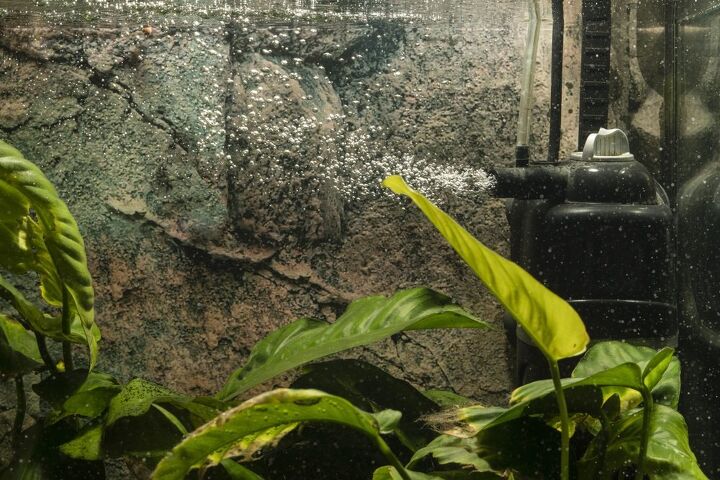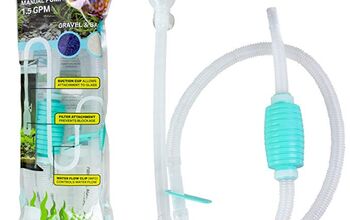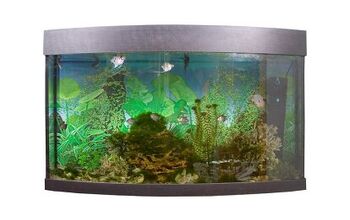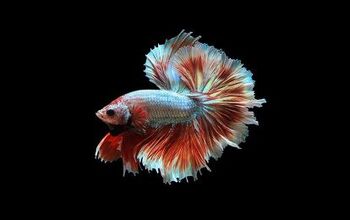Best Aquarium Filters

Go with the flow and keep your tank sparkling clean. Choose from our list of the best aquarium filters to ensure your tank is properly maintained.
Your aquarium is an enclosed environment, so the water gets dirty pretty easily. Not only are we talking about uneaten fish food and feces breaking down, but the chemical byproducts of those processes as well. If you don’t perform routine maintenance in your tank, toxins will accumulate, and it can become a deadly environment for your fish. Having a good aquarium filter in place is essential for maintaining high water quality and a safe, healthy environment for your tank inhabitants.
In this article, we’ll discuss the importance of having an adequate filtration system in your aquarium. You’ll also see our top picks for the best aquarium filters to consider for your tank.
Best Aquarium Filters
Adequate filtration is essential to maintain high water quality in your tank for the benefit of your fish. There are a variety of different aquarium filter types out there, but it is largely a matter of preference which option you choose. Canister filters are a favorite of many aquarium hobbyists because they are large, efficient, and easy to customize. Power filters tend to be a little more affordable and under-gravel filters are usually used for supplemental filtration.
Here are the best aquarium filters to consider for your tank:
1.Editor’s Pick – Penn Plax Cascade Canister Filter
Choose from a variety of sizes in this powerful canister filter made with state-of-the-art technology. It features large capacity media baskets for customization as well as a spray bar for added options.
2. Runner Up – EHEIM Classic External Canister Filter
This powerful canister filter comes with all of the accessories you need and it is available in three different sizes. With a permo-elastic silicon sealing ring, it is easy to close after cleaning and you don’t have to worry about leaks.
3. Best Power Filter – Marineland Penguin Power Filter
What makes this power filter unique is the patented Bio-Wheel technology which supports the growth of beneficial bacteria to support biological filtration in your tank. This filter comes in a variety of sizes and is compatible with Marineland Rite-Size filter cartridges to make filter maintenance quick and easy.
4. Easy To Install – AquaClear Power Filter
An affordable option available in a wide variety of sizes, this hang-on filter is quick and easy to install. Its filtration volume is up to 7 times larger than comparable models and it comes with foam, activated carbon, and BioMax and Cycle Guard to ensure continuous biological filtration.
5. Best External – Polar Aurora External Filter
This canister filter features three media trays for easy customization, and it comes with a self-priming pump to make setup quick and painless. It comes with an adjustable spray bar and a single valve disconnect for easy routine maintenance.
6. Best Canister – Marineland Magniflow Canister Filter
For efficient performance and easy maintenance, this canister filter is a must-have. It comes in three sizes to accommodate tanks up to 100 gallons and features a unique polishing filter pad to remove fine debris from the water column.
7. Best Efficiency – Fluval 307 Performance Canister Filter
Designed for efficiency and performance, this canister filter is 25% quieter than previous models and delivers constant pumping power and consistent pressure. This filter is incredibly energy efficient and offers many options for customization with filter media.
8. Best LED – Aqueon QuietFlow LED Pro Aquarium Filter
This three-stage aquarium filter offers a self-priming feature and an LED indicator light to let you know when it’s time to replace the cartridges. It also has an internal pump design to dampen noise and prevent leaks.
9. Best Hang-On – Penn Plax Cascade Hang-On Filter
Available in a variety of sizes, this hang-on filter uses revolutionary Bio-Falls Quad-Filtration system to provide maximum oxygenation. This filter keeps your tank water crystal clear and free from contaminants.
10. Best Customizable – Marineland Magnum Polishing Internal Canister Filter
If you’re looking for a powerful and efficient internal filter, this is it. This polishing internal canister filter is rated for aquariums up to 97 gallons and it has two refillable chambers so you can customize it for whatever filter media you want to use.
What to Look for in Aquarium Filters
There are three types of aquarium filtration: mechanical, chemical, and biological. Mechanical filtration involves physically removing solid waste like uneaten fish food and feces from the tank. Chemical filtration tackles dissolved wastes and toxins while biological filtration simply involves cultivating a colony of beneficial bacteria in the tank to help maintain balance. A good aquarium filter will incorporate all three types of filtration, though there are several different models to choose from.
Here are some things to look for when shopping for an aquarium filter:
- Filter Type – The type of filter you choose is largely a matter of preference but consider the pros and cons of the different options before you decide.
- Size/Flow Rate – Aquarium filters are rated for tanks of different sizes according to their flow rate – it’s best to choose a larger filter than you need rather than a smaller one.
- Filter Media – The filter media is what provides the filtration benefits, so be sure to choose a filter that incorporates mechanical, chemical, and biological filter media.
- Maintenance – You’ll need to change your filter media once a month and clean the filter as well – look for a model that is easy to disassemble and reassemble after cleaning.
- Convenience – Some filters come with convenience features like self-priming pumps that save you from the hassle of having to siphon water.
No matter what type of aquarium filter you choose, it’s important to keep it properly maintained. Changing your filter media every few weeks and cleaning the filter once a month will keep it in working order. Do a quick check on your filtration system once a week to make sure things are still running and clean the parts a few at a time instead of doing it all at once. This way you avoid killing off too many of the beneficial bacteria living in your filter.
Basics of Aquarium Filters and Pumps
Luckily, PetGuide.com’s experts will make sure you have no trouble keeping your fish tank in an optimal state. When it comes to the basics, our extensive buying guides and detailed reviews on aquarium pumps and filter are a perfect resource for seasoned hobbyists and beginner aquarists alike. Whether you need help choosing a perfect filtration system for your tank, wonder if you need a submersible pump or an in-line one, or want to check the pros and cons of the filter and pump combo systems, you’ve come to the right place. Armed with information from our blog, you won’t ever feel like a fish out of water when it comes to aquaristics!
What You Need to Know About Aquarium Filters and Pumps
When it comes to aquarium pumps and filters, there are a few things you need to know about before you pick out a specific make and model for your aquarium. A water pump will power your filter, ensure there’s movement of water in the tank, and, in some cases, power additional gear in the aquarium, such as protein skimmers. To make sure you’re choosing the right one, take into account the size of your tank, its type (species in saltwater tanks require more power from pump than freshwater ones), as well as the location where the pump will be- as there are two types of water pumps, one kept inside the water and other above it, this will be important to know.
Submersible water pumps are, as the name suggests, those who are submerged underwater, usually placed inside the infiltration basin of an aquarium filter. Some of the reasons why people prefer submersible pumps is that they are much quieter during work, as the water blocks much of the noise, and they are also much easier to install than the alternative, which requires some craftiness from your side. In-line water pumps, on the other hand, are connected to the inlet hose and outlet hose of your filter and their main advantages are their impressive power and the fact that they won’t increase the temperature of the water, as they’re not in it. Depending on the fish breeds and plant life you keep in your tank, one of the two types will be a better match for you- find out which at PetGuide.com. Our guides ensure that you pick the best aquarium pumps and filters for your flora and fauna, and help you find a specific brand and model of the needed gear that will fit inside your budget.
The Purpose of Aquarium Filters
While pumps will power your aquarium’s equipment, fish tank filters will keep the water in it clean, making sure your aquarium inhabitants are healthy and thriving, and that there’s not much maintenance for you to do. In their natural habitat, the water they live has a balanced pH and is cleaned through natural processes, whereas inside the tank, your aquatic friends rely on you to provide them with a healthy living environment. To do so, you will need a whole filtration system, which consists of three stages: mechanical, chemical, and bacterial filtration. A good aquarium filter goes through all three stages on its own!
The Filtration System
The first, mechanical filtration means that it will clean waste and debris floating in the tank. Chemical filtration ensures that unwanted chemicals or excess nutrients are filtered out of the water and that it’s well-balanced for flora and fauna living in it. Last, we have bacterial component, which is also called nitrogen cycle, controls the levels of ammonia and oxygen with help of beneficial bacteriae. Of course, this is just the nitty-gritty of the process: there is so much more to aquarium filtration than it meets the eye! Fortunately, you won’t get overwhelmed by tons of contradicting information from different sources- PetGuide.com’s experts have prepared extensive resources on aquarium filters that have all the scoop you need in one place. From choosing the best aquarium pumps and filters with the help of our reviews to learning how to properly clean your gear, and much more, PetGuide.com is the place to be.
Without high-quality and adequately chosen equipment, the flora and fauna in your fish tank are bound to deteriorate with time. To make sure their basic needs are met and that their living environment is up to their standards, you’ll need aquarium pumps and filters that match your tank’s type. Our experts can help you choose the gear your aquarium needs, and it’s not only aquarium pumps and filters we have extensively written about: make sure to visit our blog on aquarium lights, heaters, hoods, cleaners, decor, and much more.
What types of Aquarium filters are there?
The most popular aquarium filter types are canister filters, internal or submersible filters, hang-on-back (HOB) filters, sump tanks, overhead filters, trickle, and under-gravel filters. Each has its pros and cons, depending on your type of tank and budget. These filters can use mechanical, chemical, or biological filtration to keep the water in the tank optimal for the inhabitants, but the best filters combine all of the filtration systems into a single design.
What to look for when choosing aquarium filters?
In addition to the filter type, you will have to pay attention to several other factors when choosing an aquarium filter. The size of your tank will dictate your choice as well as the inhabitants, so choose the filter accordingly. Look for size and flow rate that corresponds to the size of your aquarium, the filtering media (the best filters have mechanical, chemical, and biological filtration)
How should I maintain my aquarium filter?
Maintenance is essential if you want your aquarium filter to work without a hitch and do so for a long time. The best practice is to replace filtering media every couple of weeks and thoroughly clean the filter body once a month. In between these deep cleanings, you should make sure to check up on the filter every few days to ensure it is working properly and clean any easily visible/reachable grime to minimize the effort needed for the “big” monthly clean.
How do aquarium filters work?
Aquarium filters remove both physical and soluble waste from aquarium water. There are three types of aquarium filtration: mechanical, chemical, and biological, and filters can rely either on one of these technologies or multiple. Filters with mechanical filtration remove and trap free-floating waste (such as feces or uneaten food), and usually are not enough on their own to keep the tank spotless. Chemical filtration uses adsorbents such as activated carbon to dissolve any particles left behind by a mechanical filter or remove organic pollutants which a mechanical filter couldn’t remove in the first place. Last but not least, biological aquarium filters keep the balance in the tank by introducing beneficial bacteria colonies that break down and convert ammonia into nitrites.
What size filter should I get for my tank?
The size of your tank is what determines the size of the filter you’ll need- or, more precisely, the flow rate of the filter. A good rule of thumb is that the filter should be able to move all of the water in the tank four times within one hour, so say you have a 50-gallon tank- you need a filter with a flow rate of 200 GPH (gallons per hour). Of course, sometimes the type of fish or other aquatic pets you keep in the tank will be what’s the determining factor: some prefer a more lively environment (high flow filters) and others thrive in calm waters (low flow filters), so tailor your decision according to the fauna living in your aquarium, as well.
Should aquarium filters always be on?
Yes, the filters in your tank have to be on 24/7. Not only that the filter keeps the water clean, but it also ensures it is habitable by oxygenating it, so turning it off, even for the night, could seriously endanger the fish living in the tank. If it’s the noise that’s bothering you and prompting you to consider turning the filters off for the night, check if the filters are noisy because they need deeper cleaning or simply go for one of the low-noise aquarium filters for peace and quiet.
Additional Resources:
We are committed to finding, researching, and recommending the best products. We earn commissions from purchases you make using the retail links in our product reviews. Learn more about how this works.

Kate Barrington is the loving owner of two cats (Bagel and Munchkin) and a noisy herd of guinea pigs. Having grown up with golden retrievers, Kate has a great deal of experience with dogs but labels herself a lover of all pets. Having received a Bachelor's degree in English, Kate has combined her love for pets and her passion for writing to create her own freelance writing business, specializing in the pet niche.
More by Kate Barrington

































